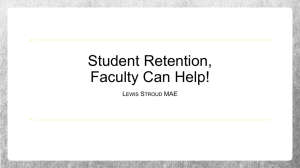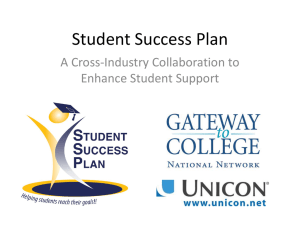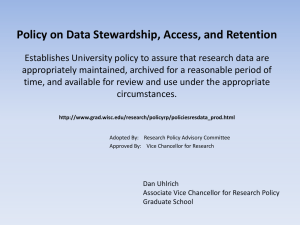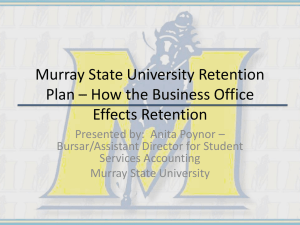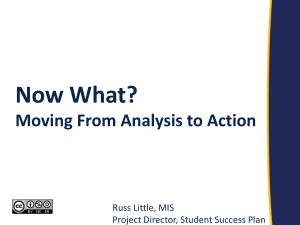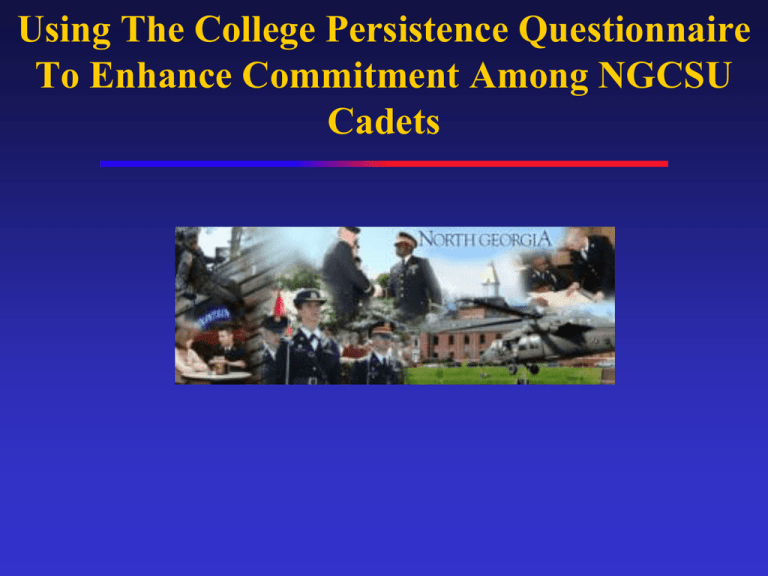
Using The College Persistence Questionnaire
To Enhance Commitment Among NGCSU
Cadets
Back In The Antediluvian Days
Why the Increased Emphasis on Retention
1. Financial and legislative pressures on colleges.
2. Global economy and automation: Heighten the need for
skilled versus semi- and unskilled labor
3. Schools are becoming more sensitive to students’ needs.
4. Death of a dream: Failure to graduate often leads to
reductions in students’ income and quality of life
Some Students Have Special Requirements
What Do We Need To Know About Our Students?
It Depends Upon Your Responsibilities
Working With Individual Students: What
Counselors, Advisors and Faculty Need To Know
1. Which cadets are most at-risk?
2. What factor(s) are causing a particular cadet to leave the
Corps?
3. We need scale scores and responses to individual items.
CPQ Advisor Portal
https://www.beckdavidson.com/welcome/welcome.aspx
Working With Groups of Students: What
Policy-Makers and Instructors Of
Persistence-Oriented Courses Need To Know
1. What factor(s) distinguish students at their schools
who will persist and will not persist in their
educations?
2. Are our retention programs effective?
Six Revelations On The Path To An Effective Retention
Program (Part 1)
Revelation
What That Means
1. We have a retention
problem.
Yes, every school has a retention problem. Some
schools have a greater problem than others.
Nevertheless, every school includes students that do
not graduate who have the capacity to graduate.
2. Someone needs to do
something.
Retention problems will not just disappear; they
cannot be ignored except at great cost, they must be
addressed. Following this revelation, a policy maker
often tasks someone or a group to deal with the
retention issue.
3. We need to know what
works.
You know there is a problem. Now you need to
determine what it is and what to do about it. A
common practice is for schools to model their initial
retention activities after a sister school that claims
success or a program reported in the empirical
literature.
Six Revelations On The Path To An Effective Retention
Program (Part 2)
Revelation
What That Means
4. We need to know if our
activities decrease attrition.
Many schools believe that their retention-reducing activities
are effective. Few schools, however, could provide a skeptic
with information demonstrating that their activities are
attenuating attrition or having beneficial effects. Realizing
this is a big step forward.
5. We need to focus our
resources, time, and energy
on those activities that will
have the greatest impact on
our students.
Knowing what affects retention at your school is not
enough. We must prioritize. There are more variables that
affect persistence decisions than any school can address.
Resources are limited so we must concentrate our energies
on those variables that most strongly influence retention at
our institution.
6. We need to establish an
ongoing data collection
system to evaluate our
progress, augment our
strengths, and overcome our
weaknesses.
Students change, schools change, programs change. An inplace assessment system will allow us to demonstrate our
achievements, make steady improvements, and
accommodate changes to our educational systems.
Strategies For Improving Retentioin
Rely On Someone’s Professional Expertise
Subject matter experts (SMEs) have invaluable
experience. Most of us were employed because we are
military and/or academic SMEs.
Rely On Someone’s Professional Expertise
Problems With SMEs: SMEs can make mistakes.
Some SMEs may not fully appreciate the
consequences of their decisions.
Rely On Someone’s Professional Expertise
King
MacArthur
Marshall
Problems With SMEs: Even the most expert of SMEs
sometimes disagree. How do you determine whose
position to support?
Look To The Literature For Guidance
In comparison to continuing-generation (CG) students firstgeneration (FG) students tend to be:
1. Female
2. Older
3. Have dependents
4. From a lower SES
FG students also tend to have:
1. Lower standardized test scores
2. Poor math, reading and critical thinking skills
3. Low self-images
4. Higher attrition rates
5. Poor grades
6. Low levels of academic and social integration
Problem With Relying On The Literature
The Golden Path To Effective Intervention:
Attitude
Can You Imagine
Someone’s
Photograph In This
Box?
Aiming for 100% Retention is an unrealistic
and counterproductive goal. Not everyone
should be a military officer.
The Golden Path To Effective Intervention:
Attitude
Take the offensive! We have nothing to be
defensive about regarding retention. Our
mission is to clear a path for others to follow.
The Golden Path To Effective Intervention:
Empirical Evidence
Data Driven Decision Making
Goals In Developing the CPQ
1. Greatest Unmet Need: A better way of determining how
students respond to the first 6 or 8 weeks of college
2. We need an instrument of great breadth that is applicable at
many schools and many types of students.
3. The instrument must provide information pertinent to
personnel working with individuals as well as groups of
students.
4. The instrument must identify the factors that most strongly
govern retention at a particular school or for a particular
individual.
5. The instrument must not be too long.
6. Data must be immediately available; we can’t wait.
7. The instrument must have a mechanism for addressing
issues pertinent to a particular school.
Development of the CPQ-1: Procedure
1. Conducted an extensive review of the retention
literature, at least 150 studies
2. Identified at least 85 variables (WOW) that had
been associated with retention
3. Wrote items addressing these 85 variables
4. Automated the administration and data recording
system
5. Administered the questionnaire to more than 2000
students
Simplify, Simplify, Simplify: Why Thoreau
Would Like Factor Analysis
1. Reduced 85 variables to 6 factors
2. Scales tend to be more reliable than single items
3. Findings reported in Journal of College Student
Retention
Reasons For Developing CPQ-2
1. Several CPQ-1 scales could benefit from additional
items.
2. Version 1 did not assess financial pressures, the
motivation to perform academic work, or the student’s
belief that he or she was capable of performing
successfully.
CPQ Components: Student Background
Form
The Student Background Form consists of three types
of items:
1. Demographic and Family: (e.g., sex, ethnicity, marital
status, parent’s education)
2. Work and Financial Resources: (e.g., hours working,
sources of income)
3. Reasons For Attending: (e.g., reputation, location, friends)
Principal Components Analysis:
Participants and Procedure
1. Two thousand eight hundred and thirty-eight
undergraduates from Angelo State University,
Appalachian State University, Greenville
Technical College, and Troy UniversityMontgomery served.
2. Students responded online, most taking less than
40 minutes to complete the 82-item
questionnaire.
Results
1. Responses were converted to 5-point “favorability”
scores, depending on whether the answer indicated
something positive or negative about the student’s
college experience. The solution produced ten
factors with eigenvalues greater than 1.0.
2. A principal components analysis was performed on
the favorability scores of the 82 items using a direct
oblimin rotation.
3. All items with pattern coefficients of .40 or higher
were retained for further analysis.
Results Just Keep On Coming
5. A second principal components analysis with a
direct oblimin rotation was conducted on the resultant
54 items to ensure that the deletion of questions did
not cause substantial changes in the pattern
coefficients.
6. The findings of the two analyses were similar. Item
deletion did not have a pronounced effect on the
coefficients.
7. All correlations between components were less than
.32.
8. Alpha levels were in excess of .70 for all factors.
CPQ Components: Student Experience Form
1. Institutional Commitment: Loyalty, intention to reenroll,
confidence in school choice
2. Degree Commitment: Personal importance, students’
supportive network, value of degree
3. Academic Integration: Positive views of instruction,
instructors, and own intellectual growth; awareness of
connections between academics and career.
4. Social Integration: Sense of belonging, shared values,
and similarity to others; positive involvement
behaviors.
5. Collegiate Stress: Feelings of distress, pressure, and
sacrifice.
CPQ Components: Student Experience Form
6. Academic Motivation: Interest and enjoyment in
academic tasks; willingness to spend extra time.
7. Scholastic Conscientiousness: Timely performance of
academic responsibilities.
8. Academic Efficacy: Confidence in academic skills and
outcomes.
9. Financial Strain: Financial worries and difficulties;
sense of disadvantage relative to others.
10. Advising Effectiveness: Positive views of advising and
school communication processes.
Did Anyone Notice?
That The Ten Student Experience Scales Of
The CPQ Assess Many Of The Variables
Composing Institutional Effectiveness
CPQ Components: Institution Specific Form
This form addresses questions not covered by the CPQ but are
important to the Corps of Cadets.
1. How confident are you that the Corps of Cadets is right for
you?
2. How do you feel about the Corps’ PT requirement?
3. How likely is it that you will participate in the Corps next
semester?
4. How do you feel about the policy of requiring cadets to
wear a military uniform while on campus?
CPQ Components: Institution Specific Form
5. How do you feel about mandatory quarters for beginning
Cadets?
6. During your last year in high school, on the average how
much time did you spend in exercise or sports?
7. How likely is it that you will complete eight semesters (or
equivalent) of military science?
8. How do you feel about the residency policy where you
must withdraw from the university for one academic year if
you drop out of the Corps of Cadets?
How Well Does The Field Predict Retention?
ACT Meta-Analysis
13 academic and non-Academic variables explain
17% of the variability of college retention across
students.
Validation Study:
Participants and Procedure
1. Seven hundred and forty-nine freshmen from
three comprehensive universities responded
online to the CPQ.
2. CPQ was administered six to eight weeks into
the first semester of the freshman year.
3. Most students took less than 40 minutes to
complete the questionnaire.
4. Return for next Fall semester was the criterion
variable.
Does the CPQ Predict Retention?
Identifying At-Risk Students (Individual Items)
Measures
Nagelkerke R2
HSR + SAT + Ethnicity +
Sex + Age + Class Size (df = 6)
.08
CPQ – Background Variables,
not usually in student database
(df = 12)
.18
Student Experience Items (df =
54)
.56
Using The CPQ To Understand An At-Risk Group:
Individual Items
Compared to other freshmen Student Support Services
students reported that:
1. They had a bigger influence on such matters as course
offerings, rule and regulations, and registration procedures.
2. They were more satisfied with the academic advisement
they received.
3. They more strongly preferred tasks that make extensive
use of their own ideas and allowed expression of their
individuality.
4. Fewer of their close friends were at Appalachian State.
5. It was more difficult for their families to handle the cost of
college.
CPQ Items Predicting Institutional Commitment:
Community College Data Argues For Targeting
Item
Business
Nursing
Arts & Sciences
1
Degree Commitment
Degree Commitment
Academic Integration
2
Degree Commitment
Degree Commitment
Academic Integration
3
Degree Commitment
Degree Commitment
Support Services
4
Academic Integration
Academic Integration
Acad. Conscientiousness
5
Academic Integration
Academic Integration
Support Services
6
Academic Integration
Academic Integration
Social Integration
The Importance Of Student Experiences:
Participants and Procedure
1. 701 freshmen from three comprehensive universities.
2. CPQ was administered six to eight weeks into the first
semester of the freshman year.
3. Most students took less than 40 minutes to complete the
questionnaire.
How Well Does The CPQ Predict Retention?
Regress retention (return the following Fall
semester) on the following predictor variables
Predictor Variables
Variables typically in student
database (df=15).
Variables from Background Form
not typically in database (df=12)
CPQ Student Experience Scales
Nagelkerke R
Square
.13
.23
.38
Where We Are Going
Degree
Commitment
.22
Academic
Integration
.24
.14
.33
.38
.23
.11
.05
-.07
Social
Integration
.30
Support Services
Satisfaction
Institutional
Commitment
.10
Academic
Conscientiousness
.19
Summary and Implications
1. CPQ is a valid predictor of whether freshmen will
return for their sophomore years.
2. CPQ identified why individual students dropped
out.
Summary and Implications
3. CPQ identified those variables that best distinguished
those students who would from those students who
would not continue their educations at these three
institutions.
4. This information would be very helpful to policy makers
deciding what retention programs to develop.
What Retention Activities At Your School Do You
Believe Have Been Successful? A Sample
Mentoring programs have been successful.
Small class sizes, instructors taking personal interest in
students-increasing engagement. Low student to advisor ratios
in many programs.
Reaching more students by e-mail rather than US mail.
Tutoring
The Student Solutions Center has shown some success.
What Retention Activities At Your School Do
You Believe Have Been Successful? A Sample
Meeting 1:1 with students to discuss their method of study, getting them
to set up study plans, teaching them to underline or otherwise ID key
terms in test questions, eliminating wrong answers by crossing them out,
dealing with test anxiety.
All efforts have had some impact, however, all could be improved.
The Summer Bridge Program.
Academic support in freshman dorms has been very beneficial for at-risk
or students – We have increased the number of dorm activities to foster
the growth of community and sense of home for the students.
Setting The Stage For Tomorrow
Let Me Invite You To List Three Retention Activities
That You Believe Have Been Successful at NGCSU
College Persistence Questionnaire Identifies Factors
Influencing Commitment Of Military Cadets
Goals Of This Investigation
1) Determine if the CPQ predicts commitment to the Corps
2) Identify those factors that are most strongly associated
with commitment
3) Offer guidelines for increasing the retention of Cadets at
NGCSU
4) Identify those cadets most at-risk for discontinuing their
educations
CPQ Components
1. Student Background Form: Consists of three types of
questions: Demographic and Family items (sex, ethnicity,
marital status, parent’s education), Work and Financial
Resources items (hours working, sources of income), and
Reasons for Attending Higher Education items (reputation,
location).
2. Student Experience Form: Ten psychometrically validated
scales that assess students’ interactions with the academic
and social environments.
More About CPQ Components
3. Ten Student Experience Form Scales: Institutional
Commitment, Degree Commitment, Academic Integration,
Collegiate Stress, Social Integration, Academic Motivation,
Scholastic Conscientiousness, Academic Efficacy, Financial
Strain, and Advising Effectiveness.
4. Institutional Specific Form: Additional questions pertaining
to the Corps of Cadets.
Participants and Procedure
1. 582 Cadets from NGCSU responded in groups online to the
CPQ.
2. CPQ was administered six to eight weeks into the first
semester of the freshman year.
3. Most students took less than 40 minutes to complete the
questionnaire.
Commitment To Corps And NGCSU Overlap
1. Created Commitment To Corps scale from
Institution specific items.
2. Correlation of Commitment to Corps and
Institutional Commitment scale was .71.
3. Created single scale, Commitment Scale (CS), from
corps and institutional items.
4. Cronbach’s alpha of CS was .78.
Does The CPQ Predict Commitment To The
Corps?
Concurrent Validity: Regress CS scores on items from the
Student Background and Student Experience Forms as well as
three items from the Institution Specific Form, excluding
items composing the CS scale.
F(68, 513) = 6.75, p < .001, R = .69, R2 = .47
Student Background Form
Cadets who chose NGCSU because of the following factors
were more committed than cadets not endorsing these
attributes.
1. Academics
2. Overall reputation
3. Appealing location
Student Background Form
Although these correlations were not strong, they may:
1. Aid in recruiting and identifying the types of prospective
students who are likely to stick.
2. Indicate that cadets with certain background characteristics
may need additional services once they matriculate.
Student Experience Form
1. Eight of nine Student Experience scales were statistically
significant, p < .01, two-tailed.
2. The most robust correlations with CS scores were the
Academic Integration, Degree Commitment, and Social
Integration scales. This result provides a guide to those
seeking to augment commitment to the Corps. Improvements
in the qualities underlying these scales will be particularly
effective in enhancing commitment.
3. A complementary approach is to develop an intervention for
a variable that is “networked” with other variables (e.g.,
advising).
Where We Are Going
Degree
Commitment
.22
Academic
Integration
.24
.14
.33
.38
.23
.11
.05
-.07
Social
Integration
.30
Support Services
Satisfaction
Institutional
Commitment
.10
Academic
Conscientiousness
.19
Student Background Form, Student Experience
Form, Institution Specific Form: Comparisons
1. Student Background Form: Questions entered in isolation
accounted for 16% of the variance.
2. Student Experience Form: Questions entered in isolation
accounted for 43% of the variance.
3. Institution Specific Items: Questions assessing attitudes
about requiring cadets to wear their uniform on campus, their
views on PT, and whether they exercised in high school
accounted for 15% of the variance when entered in isolation.
Two Important Takeaways
1. The Student Experience Form was a much better predictor
of commitment than any items on the Student Background
Form. This finding indicates that experiences during the
first six to eight weeks have a profound impact on
commitment.
2. It also argues against attempting to determine commitment
during orientation or at an earlier date.
Limitations And Recommendations
1. This study needs to be followed by an analogous
investigation in which retention (return for the sophomore
year) is the outcome measure.
2. The sample size was small for those regressions employing
individual items as predictors. Nevertheless, given the
strength of the findings, we can be confident of the
reliability of the outcomes.
3. It is encouraging that Student Experience items tend to be
better predictors of commitment than Student Background
items. Student Experience items are more subject to
change.
Limitations And Recommendations
4. Efforts to augment cadet retention should focus on
increasing Academic Integration, Social Integration, and
Degree Commitment.
5. An alternative strategy is to network these variables and
commitment by improving Advising Effectiveness.
6. The CPQ was administered only once in the Fall semester.
Many cadets drop out after the Spring semester. Administering
the CPQ in the Spring might identify students who were now
at-risk but were not at-risk in the Fall. Furthermore, changes
in scales scores could prove diagnostic.
What Does This Tell You About These
Cadets?
2
1.5
1
0.5
0
-0.5
-1
-1.5
-2
Smith
Jones
FALL
1.75
-0.5
SPRING
1.1
1.1
Intervention Strategies: Transforming Cadets Into
Officers
Working With Individual Students: What
Counselors, Advisors and Faculty Need To Know
1. Which cadets are most at-risk?
2. What factor(s) are causing a particular cadet to leave the
Corps?
3. We need scale scores and responses to individual items.
Two Measures of Retention
Institutional Commitment Score
Advantages: Provides a means of identifying at-risk students
after 6 weeks of college. The Student Experience variables
that are correlated with Institutional Commitment are
subject to change.
Disadvantage: Is not perfectly correlated with who actually
returns
Returning Sophomores
Advantage: Indicates who actually returns.
Disadvantage: It is too late to help at-risk students when this
data becomes available.
Beck’s List of Invariably Violated
Principles
1. The earlier the diagnosis the better the prognosis
2. More information generally enhances the prediction
of at-risk students
3. The more time you have to gather information the
more useful information you can acquire
What Do You Need To Do To Reduce
Attrition? Not An Easy Task
1. Identify at-risk students within first 6 to 8
weeks of college
2. Determine why a student is at-risk
3. Craft a powerful message that addresses that
student’s issues
4. Quickly alter the direction of that student’s life
A Tale Of Two Portals
The Student and Advisor Portals were developed
because early users of the CPQ requested an online
system.
Student Portal: Administers the CPQ to the student
and saves the information to a database.
Advisor Portal: Retrieves information from the
database and uses this information to identify at-risk
students and indicate why that individual is at-risk.
Advisor Portal: Identifying At-Risk Students
The Advisor Portal provides school personnel with
a tool for making one-on-one sessions with
students helpful, effective, and fruitful in
augmenting retention rates. It identifies individual
students who are most at-risk and supplies an indepth analysis of the problems each one is
experiencing. Testimonials of advisors and
counselors who have used it are uniformly and
overwhelmingly positive in describing its value in
their sessions with individual students.
Working With Groups of Students: What
Policy-Makers and Instructors Of
Persistence-Oriented Courses Need To Know
1. What factor(s) distinguish students at their schools
who will persist and will not persist in their
educations?
2. Are our retention programs effective?
Meta Analysis: Intervention Effects On
College Performance And Retention
1. Robbins, Oh, Le, and Button (2009)
2. Examined the effects of interventions (academic skill,
self-management, socialization, and first-year
experience) on academic performance and retention.
Results: Intervention Effects On
College Performance And Retention
1. Academic skill training (e.g., study habits,
learning strategies) had the strongest effects on
academic performance. Self-management skill
training (e.g., self-regulatory, emotional control)
had a lesser effect.
2. Self-management training had the strongest
effect on retention. Socialization interventions
also showed a significant effect on retention.
3. First-year experience programs had “weak to
negligible effects on academic performance and
retention.”
Why Do First Year Courses Have Such
Modest Effects On Retention?
Interpreting The Data
They may:
1. Be ineffective.
2. Have very broad goals which are difficult to
measure.
3. Be very diverse. Programs may very different
goals.
4. Have very little structure or guidance as to
objectives. Instructors may simply do what they
want to do and the institution may hope that this
has some benefit.
What Works In Student Retention?
Student And Institutional Characteristics
Item
Mean
Level of student preparation for college-level work
Adequacy of personal financial resources
Student study skills
Amount of financial aid available to students
3.90
3.90
3.80
3.65
Level of student motivation to succeed
Level of student commitment to earning a degree
Level of job demands on students
3.64
3.56
3.52
Student low socio-economic status
Student educational aspirations and goals
Student personal coping skills
3.49
3.36
3.34
What Works In Student Retention?
Retention Activities
Item
Mean
Academic advising center
Increased number of academic advisors
Advising interventions with selected populations
Comprehensive learning assistance center/lab
3.98
3.98
3.93
3.92
Supplemental instruction
Programs for first-generation students
Required on-campus housing for freshmen
3.91
3.90
3.86
Reading center/lab
Tutoring
Summer bridge program
3.86
3.84
3.83
What Activities Differentiate Schools With High Versus
Low Retention Rates?
Item
Increased number of academic advisors
Top Bottom
43%
30%
Advising with selected populations
Supplemental instruction
Summer bridge program
96%
75%
75%
82%
64%
49%
Program for honors students
Integration advising and first-year programs
Training for non-faculty academic advisors
Faculty mentoring
91%
72%
84%
74%
73%
48%
67%
45%
Living/learning communities (residential)
Staff mentoring
87%
57%
60%
31%
What Are The Three Most Important Retention
Activities?
Item
% Selected
Freshman seminar/university 101 (credit)
Supplemental instruction
Tutoring
Living/learning communities (residential)
24%
16%
15%
14%
Advising with selected populations
Placement in courses based on test scores
Academic advising center
14%
13%
12%
Summer orientation
Early warning system
11%
10%
Which Attrition-Reducing Activities
Should We Use?
That depends upon:
1. What variables differentiate cadets who become military
officers from those who dropout.
2. What the empirical literature indicates about the
effectiveness of various attrition-reducing practices.
3. What resources and personnel we can direct towards
retention.
How Do We Know If Our Actions Are
Hitting The Mark?
That Brings Us To Measurement Issues
Your Main Outcome Measures
1. Grades
2. Institutional Commitment
3. Sophomore Retention
Your Palette Of Measures
There must be a logical relationship between your objectives and your
measures. Your available indices include:
Measures
Retention
Academic Integration
Graduation Rates
Financial Strain
GPA
Social Integration
Institutional Commitment
Degree Commitment
High School Rank, Standardized Tests
Collegiate Stress
Background (e.g., sex, parental education)
Academic Motivation
Work and Finances (e.g., hours working)
Scholastic Conscientiousness
Reasons To Attend (e.g., friends, location)
Academic Efficacy
Institution Specific Items
Advising Effectiveness
Activities With Multiple Objectives
Activities
Training for non-faculty academic advisors
Faculty mentoring
Staff mentoring
Freshman seminar/university 101 (credit)
Early warning system
Measures: These activities are very generally stated.
Therefore, they should have very diverse effects. If
successful, a broad range of indices will be impacted. The
measures taken should depend upon the particular objectives
of the activities.
Some Attributes, Activities And Their Measures
Activities
Financial resources
Measures
Financial Strain
Motivation to succeed Academic Integration, Academic Motivation,
Scholastic Conscientiousness
Commitment to
Degree Commitment, Academic Integration
earning a degree
Job demands
Educational
aspirations
Work and Finances Section, Financial Strain
Degree Commitment, Academic Integration
Coping skills
Collegiate Stress, Scholastic
Conscientiousness, Academic Efficacy
High School Rank, Standardized Tests,
Multiple Student Experience Scales
Preparation for
college-level work
Assessing At-Risk Or Special Populations
Activities
Students of low socio-economic status
Advising interventions with selected student populations
Programs for first-generation students
Programs for honors students
Programs for minority students
Measures: These activities attempt to address problems common to atrisk or special populations. Measures on the Student Background Form
(e.g., parents’ education, ethnicity) and student database could help
identify these groups. The goals of these programs vary considerably,
therefore, the measures used to assess their effectiveness varies
accordingly.
Academic Enhancement Activities
Activities
Student study skills
Comprehensive learning assistance center/lab
Supplemental instruction
Reading center/lab
Tutoring
Placement of students in courses based on test scores
Program for honors students
Measures: Academic Integration, Academic Efficacy,
Academic Motivation, Scholastic Conscientiousness,
Collegiate Stress.
Social Integration Activities
Activities
Required on-campus housing for freshmen
Living/learning communities (residential)
Program for international students
Summer bridge program
Integration of advising with first-year transition programs
Summer orientation programs
Measures: A major objective of these activities appears to be to enhance
the extent that students identify with and feel part of the academic
community. Other objectives of these programs should be measured, in
addition to the Social Integration scale of the CPQ.
Advising Activities
Activities
Academic advising center
Increased number of academic advisors
Advising interventions with selected student populations
Measures: Advising is critical because it networks with so
many other variables. The Advising Effectiveness scale of the
CPQ should be used to assess these endeavors. Other
variables, depending on the goals of the program should also
be measured..
What Is A Reasonable Assessment Strategy?
1. Gather attrition-related information from your
Institutional Research Office.
2. Administer the CPQ to obtain Student Background
and Experience variables.
3. Combine the Institutional Research and CPQ
variables into a dataset.
4. Determine who returns the following Fall semester.
5. Annually prepare Institutional Commitment and
Retention reports.
6. Examine data across years to anticipate trends.
For Your Attention.
Do Not Be A Stranger.
This Is A beginning,
Not An Ending!


